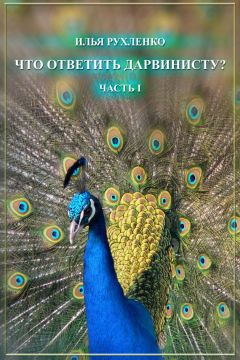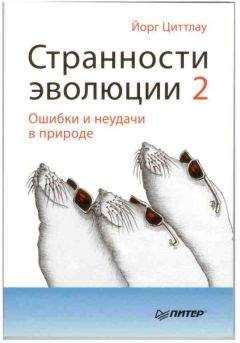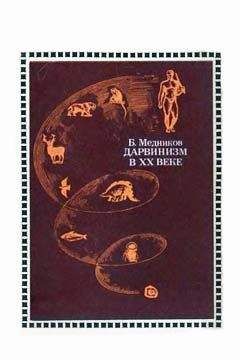Илья Рухленко - Что ответить дарвинисту? Часть II
Dawkins R. The extended phenotype. Oxford University Press, 1982. – 307 p.
DeSalle R., Gatesy J., Wheeler W., Grimaldi D. DNA sequences from a fossil termite in Oligo-Miocene amber their phylogenetic implications // Science. 1992. V. 257. № 5078. P. 1933–1936.
Dias B.G., Ressler K.J. Parental olfactory experience influences behavior and neural structure in subsequent generations // Nature Neuroscience. 2013. V. 17. P. 89–96.
Diegisser T., Seitz A., Johannesen J. Morphological adaptation in host races of Tephritis conura // Entomologia Experimentalis et Applicata. 2007. V. 122. № 2. P. 155–164.
Dres M., Mallet J. Host races in plant-feeding insects and their importance in sympatric speciation. Philosophical Transactions of the Royal Society of London B. 2002. V. 357. P. 471–492.
Du Toit J.T. Feeding-height stratification among African browsing ruminants // African Journal of Ecology. 1990. V. 28. P. 55–61.
Edgell T.C. The geography of inducible defence in a marine snail // The Malacologist. 2008. V. 50. P. 30–31. http:// www.malacsoc.org.uk/the_Malacologist/BULL50/Edgell.htm
Edgell T.C., Neufeld C.J. Experimental evidence for latent developmental plasticity: intertidal whelks respond to a native but not an introduced predator // Biol Lett. 2008. V. 4. P. 385–387.
Edwards N.P., Barden H.E., van Dongen B.E., Manning P.L., Larson P.L., Bergmann U., Sellers W.I., Wogeleus R.A. Infrared mapping resolves soft tissue preservation in 50 million year-old reptile skin // Proc. R. Soc. B. 2011. V. 278. P. 3209–3218.
Elmer K.R., Lehtonen T.K., Kautt A.F., Harrod C., Meyer A. Rapid sympatric ecological differentiation of crater lake cichlid fishes within historic times // BMC Biology. 2010. V. 8. P. 60.
Eronen M., Zetterberg P., Briffa K.R., Lindholm M., Merilainen J., Timonen M. The supra-long Scots pine tree-ring record for Finnish Lapland: part 1, chronology construction and initial inferences // The Holocene. 2002. V. 12. P. 673–680.
Feder J.L. The effects of parasitoids on sympatric host races of Rhagoletis pomonella (Diptera: Tephritidae) // Ecology. 1995. V. 76. № 3. P. 801–813.
Feder J.L., Reynolds K., Go W., Wang E.C. Intra– and interspecific competition and host race formation in the apple maggot fly, Rhagoletis pomonella (Diptera: Tephritidae) // Oecologia. 1995. V. 101. № 4. P. 416–425.
Fikacek M., Prokin A., Angus R.B. A long-living species of the hydrophiloid beetles: Helophorus sibiricus from the early Miocene deposits of Kartashevo (Siberia, Russia) // Zookeys. 2011. V. 130. P. 239–254.
Filchak K.E., Roethele J.B., Feder J.L. Natural selection and sympatric divergence in the apple maggot Rhagoletis pomonella // Nature. 2000. V. 407. №. 6805. P. 739–742.
Fisher J.A.D., Rhile E.C., Liu H., Petraitis P.S. An intertidal snail shows a dramatic size increase over the past century // Proc Natl Acad Sci USA. 2009. V. 106. P. 5209–5212.
Forbes A.A., Powell T.H.Q., Stelinski L.L., Smith J.J., Feder J.L. Sequential sympatric speciation across trophic levels // Science. 2009. V. 323. № 5915. P. 776–779.
Freeman A.S., Byers J.E. Divergent induced responses to an invasive predator in marine mussel populations // Science. 2006. V. 313. P. 831–833.
Freeman A.S., Byers J.E. Response to comment on “Divergent induced responses to an invasive predator in marine mussel populations” // Science. 2007. V. 316. P. 53.
Gallant J.R., Traeger L.L., Volkening J.D., Moffett H., Chen P., Novina C.D., Phillips Jr. G.N., Anand R., Wells G.B., Pinch M., Guth R., Unguez G.A., Albert J.S., Zakon H.H., Samanta M.P., Sussman M.R. Genomic basis for the convergent evolution of electric organs // Science. 2014. V. 344. P. 1522–1525.
Garwood R.J., Dunlop J.A., Giribet G., Sutton M.D. Anatomically modern Carboniferous harvestmen demonstrate early cladogenesis and stasis in Opiliones // Nature Communications 2. 2011. Article number: 444. doi:10.1038/ncomms1458
Gibson D.G., Benders G.A., Andrews-Pfannkoch C., Denisova E.A., Baden-Tillson H., Zaveri J., Stockwell T.B., Brownley A., Thomas D.W., Algire M.A., Merryman C., Young L., Noskov V.N., Glass J.I., Venter J.C., Hutchison III C.A., Smith H.O. Complete chemical synthesis, assembly, and cloning of a Mycoplasma genitalium genome // Science. 2008. V. 319. № 5867. P. 1215–1220.
Glass K., Ito S., Wilby P.R., Sota T., Nakamura A., Bowers C.R., Vinther J., Dutta S., Summons R., Briggs D.E.G., Wakamatsu K., Simon J.D. Direct chemical evidence for eumelanin pigment from the jurassic period // PNAS. 2012. V. 109. № 26. P. 10218-10223.
Golenberg E.M., Giannasi D.E., Clegg M.T., Smiley C.J., Durbin M., Henderson D., Zurawski G. Chloroplast DNA sequence from a Miocene Magnolia species // Nature. 1990. V. 344. P. 656–658.
Gore P.J.W. Triassic Notostracans in the newark supergroup, Culpeper Basin, Northern Virginia // Journal of Paleontology. 1986. V. 60. № 5. P. 1086–1096.
Gould S.J. Evolution's erratic pace // Natural History. 1977. V. 86. № 5. P. 14.
Grant B.R., Grant P.R. Evolution of Darwin’s finches caused by a rare climatic event // Proc. R. Soc. Lond. B. 1993. V. 251. P. 111–117.
Grant B.R., Grant P.R. Natural selection in a population of Darwin’s finches // Am. Nat. 1989. V. 133. P. 377–393.
Grant P.R., Grant B.R. Predicting microevolutionary responses to directional selection on heritable variation // Evolution. 1995. V. 49. P. 241–251.
Grant P.R., Grant B.R. Unpredictable evolution in a 30-year study of Darwin’s finches // Science. 2002. V. 296. P. 707–711.
Greenblatt C.L., Baum J., Klein B.Y., Nachshon S., Koltunov V., Cano R.J. Micrococcus luteus – survival in amber // Microb Ecol. 2004. V. 48. № 1. P. 120–127.
Hairston N.G., Ellner S.P., Geber M.A., Takehito Y., Fox J.A. Rapid evolution and the convergence of ecological and evolutionary time // Ecology letters. 2005. V. 8. P. 1114–1127.
Hall B.G. Adaptive evolution that requires multiple spontaneous mutations: mutations involving base substitutions // Proc. Natl. Acad. Sci. USA. 1991. V. 88. P. 5882–5886.
Harris M.P., Hasso S.M., Ferguson M.W.J., Fallon J.F. The development of Archosaurian first-generation teeth in a chicken mutant // Current Biology. 2006. V. 16. № 4. P. 371–377.
Hebsgaard M.B., Phillips M.J., Willerslev E. Geologically ancient DNA: fact or artifact? // Trends in Microbiology. 2005. V. 13. № 5. P. 212–220.
Hegna T.A., Ren D. Two new «notostracans», Chenops gen. nov. and Jeholops gen. nov. (Crustacea: Branchiopoda:?Notostraca) from the Yixian Formation, Northeastern China // Acta Geologica Sinica. 2010. V. 84. № 4. P. 886–894.
Herrel A., Huyghe K., Vanhooydonck B., Backeljau T., Breugelmans K., Grbac I., Van Damme R., Irschick D.J. Rapid large-scale evolutionary divergence in morphology and performance associated with exploitation of different dietary resource // PNAS. 2008. V. 105. № 12. P. 4792–4795.
Hopkins R., Rausher M.D. Pollinator-mediated selection on flower color allele drives reinforcement // Science. 2012. V. 335. P. 1090–1092.
Husak J.F. Ecological and evolutionary significance of locomotor performance in collared lizards (Crotaphytus collaris). PhD Dissertation. Oklahoma State University, Stillwater, Oklahoma. 2005.
Husak J.F. Does speed help you survive? A test with collared lizards of different ages // Functional Ecology. 2006. V. 20. P. 174–179.
Husak J.F., Ribak G., Wilkinson G.S., Swallow J.G. Compensation for exaggerated eye stalks in stalk-eyed flies (Diopsidae) // Functional Ecology. 2011. V. 25. P. 608–616.
Jahren A.H., Sternberg L.S.L. Eocene meridional weather patterns reflected in the oxygen isotopes of arctic fossil wood // GSA Today. 2002. V. 12. № 1. P. 1–9.
Jenkin F. The origin of species. Art. I. // North Brit. Rev. 1867. V. 46. P. 277–318.
Jones A.G., Ratterman N.L. Mate choice and sexual selection: What have we learned since Darwin? // PNAS. 2009. V. 106. № 1. P. 10001–10008.
Jones Z.M., Jayne B.C. Perch diameter and branching patterns have interactive effects on the locomotion and path choice of anole lizards // The Journal of Experimental Biology. 2012. V. 215. P. 2096–2107.
Kameneva E.P. A new species of the genus Plagiocephalus (Diptera, Ulidiidae) from Central America // Vestnik zoologii. 2004. V. 38. № 4. P. 15–22.
Kaye T.G., Gaugler G., Sawlowicz Z. Dinosaurian soft tissues interpreted as bacterial biofilms // PLoS ONE. 2008. V.3. № 7. P. e2808.
Kelber K.-P. New Triopsids (Crustacea, Notostraca) from the Upper Triassic of Frankonia, Germany / Epicontinental Triassic International Symposium. Hallesches Jb Geowissenschaften Beiheft. 1998. V.5. P 85.
Kim S., Soltis D.E., Soltis P.S., Suh Y. DNA sequences from Miocene fossils: an ndhF sequence of Magnolia latahensis (Magnoliaceae) and an rbcL sequence of Persea pseudocarolinensis (Lauraceae) // Am. J. Bot. 2004. V. 91. № 4. P. 615–620.
Klutsch C.F.C., Misof B., Grosse W.-R., Moritz R.F.A. Genetic and morphometric differentiation among island populations of two Norops lizards (Reptilia: Sauria: Polychrotidae) on independently colonized islands of the Islas de Bahia (Honduras) // Journal of Biogeography. 2007. V. 34. P. 1124–1135.
Kolbe J.J., Leal M., Schoener T.W., Spiller D.A., Losos J.B. Founder effects persist despite adaptive differentiation: a field experiment with lizards // Science. 2012. V. 335. P. 1086–1089.
Larralde R., Robertson M.P., Miller S.L. Rates of decomposition of ribose and other sugars: implications for chemical evolution // Proc. Natl. Acad. Sci. USA. 1995. V. 92. P. 8158–8160.
Lee M.S.Y., Jago J.B., Garcia-Bellido D.C., Edgecombe G.D., Gehling J.G., Paterson J.R. Modern optics in exceptionally preserved eyes of Early Cambrian arthropods from Australia // Nature. 2011. V. 474. P. 631–634.
Leuschner H.H., Sass-Klaassen U., Jansma E., Baillie M.G.L., Spurk M. Subfossil European bog oaks: population dynamics and long-term growth depressions as indicators of changes in the Holocene hydro-regime and climate // The Holocene. 2002. V. 12. P. 695–706.
Leuthold B.M., Leuthold W. Food habits of giraffe in Tsavo National Park, Kenya // East African Wildlife Journal. 1972. V. 10. P. 129–141.
Levy M., Miller S.L. The stability of the RNA bases: implications for the origin of life // Proc. Natl. Acad. Sci. USA. 1998. V. 95. P. 7933–7938.
Liebers D., de Knijff P., Helbig A.J. The herring gull complex in not a ring species // Proc Biol Sci. 2004. V. 271. № 1542. P. 893–901.
Lindgren J., Uvdal P., Engdahl A., Lee A.H., Alwmark C., Bergquist K-E., Nillson E., Ekstrom P., Rasmussen M., Douglas D.A., Polcyn M.J., Jacobs L.L. Microspectroscopic evidence of cretaceous bone proteins // PLoS ONE. 2011. V. 6. № 4. P. e19445.
Lindstrom T., Brown G.P., Sisson S.A., Phillips B.L., Shine R. Rapid shifts in dispersal behavior on an expanding range edge // PNAS. 2013. V. 110. № 33. P. 13452-12456.
Linn C., Dambroski H.R., Feder J.L., Berlocher S.H., Nojima S., Roelofs W.L. Postzygotic isolating factor in sympatric speciation in Rhagoletis flies: Reduced response of hybrids to parental host-fruit odors // PNAS. 2004. V. 101. № 51. P. 17753-17758.
Linn C., Feder J.L., Nojima S., Dambroski H.R., Berlocher S.H., Roelofs W. Fruit odor discrimination and sympatric host race formation in Rhagoletis // PNAS. 2003. V. 100. № 20. P. 11490-11493.
Llewellyn D., Thompson M.B., Phillips B.L., Brown G.P., Shine R. Reduced investment in immune function in invasion-front populations of the cane toad (Rhinella marina) in Australia // Biological Invasions. 2012. V. 14. P. 999–1008.
Logan M.L., Montgomery C.E., Boback S.M., Reed R.N., Campbell J.A. Divergence in morphology, but not habitat use, despite low genetic differentiation among insular populations of the lizard Anolis lemurinus in Honduras // Journal of Tropical Ecology. 2012. V. 28. P. 215–222.
Losos J.B., Schoener T.W., Langerhans R.B., Spiller D.A. Rapid temporal reversal in Predator-Driven Natural Selection // Science. 2006. V. 314. № 5803. P. 1111.
Loyau A., Jalme M.S., Sorci G. Intra– and intersexual selection for multiple traits in the peacock (Pavo cristatus) // Ethology. 2005. V. 111. P. 810–820.
Luck N., Joly D. Sexual selection and mating advantages in the giant sperm species, Drosophila bifurca // Journal of Insect Science. 2005. V. 5. P. 10.
Ma X., Cong P., Hou X., Edgecombe G.D., Strausfeld N.J. An exceptionally preserved arthropod cardiovascular system from the early Cambrian // Nature Communications 5. 2014. Article number: 3560. doi: 10.1038/ncomms4560.
Ma X., Hou X., Edgecombe G.D., Strausfeld N.J. Complex brain and optic lobes in an early Cambrian arthropod // Nature. 2012. V. 490. P. 258–261.
Maisnier-Patin S., Roth J.R., Fredriksson A., Nystrom T., Berg O.G., Andersson D.I. Genomic buffering mitigates the effects of deleterious mutations in bacteria // Nature Genetics. 2005. V. 37. № 12. P. 1376–1379.
Manning P.L., Morris P.M., McMahon A., Jones E., Gize A., Macquaker J.H.S., Wolff G., Thompson A., Marshall J., Taylor K.G., Lyson T., Gaskell S., Reamtong O., Sellers W.I., van Dongen B.E., Buckley M., Wogelius R.A. Mineralized soft-tissue structure and chemistry in a mummified hadrosaur from the Hell Creek Formation North Dakota (USA) // Proc. R. Soc. B. 2009. doi:10.1098/rspb.2009.0812
McHenry C.R., Wroe S., Clausen P.D., Moreno K., Cunningham E. Supermodeled sabercat, predatory behavior in Smilodon fatalis revealed by high-resolution 3D computer simulation // PNAS. 2007. V. 104. № 41. P. 16010-16015.
Mitchell G., Van Sittert S., Skinner J.D. The demography of giraffe deaths in a drought // Transactions of Royal Society of South Africa. 2010. V. 65. № 3. P. 165–168.




